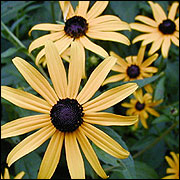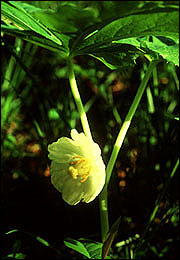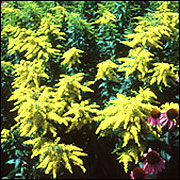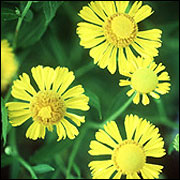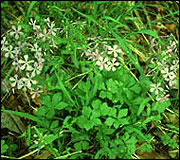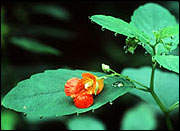The word wildflower seems a contradiction when used to describe plants growing in the garden. How can a plant growing in cultivation be wild? The word means different things to different people, but all plants we grow were at some time wild somewhere. In modern use, however, wildflower refers to a plant that has not undergone any change or improvement by humans and usually is still found growing natively somewhere in the region where it is being cultivated.
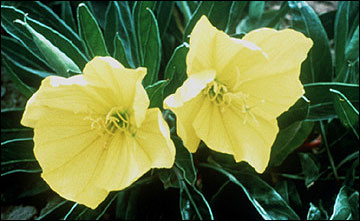 The Missouri primrose is a native wildflower well adapted to home landscapes.
The Missouri primrose is a native wildflower well adapted to home landscapes.
Why grow wildflowers?
Some people grow wildflowers because they consider them hardy and durable and believe that wildflowers can be grown in the garden with little care. This is true for some plants, but others need specific conditions to grow and thrive. Without these special conditions, some wildflowers will decline and eventually die.
Many sites are too shaded or too open for popular garden flowers. Wildflowers often are well adapted to these sites and do not need extensive maintenance if a less manicured landscape appearance is acceptable.
Conservation of wildflowers
Wildflowers are found in a wide range of habitats. Those that are rare, threatened or endangered should never be removed from their native habitat. Moreover, removing any wildflower, endangered or not, from public land is unlawful. This includes highway rights of way. Anyone interested in growing wildflowers should select those that can be propagated, or grown, from seeds or in other ways for use in the garden. Avoid digging from native locations unless they are being destroyed for some reason.
A number of reputable garden wildflower producers exist. In addition to mail-order sources, you may have wildflower nurseries near your home. Check with local nurseries and garden centers to determine whether local sources are available. Some dealers dig plants from the wild and sell directly, or perhaps hold plants that have been dug from the wild for a few months to a year before selling them. For the sake of conservation, plants grown from seeds or from native stock for many years should be favored over those dug from wild stands. Plants not dug from the wild may cost more, but they will be more successful in the garden and you will not be contributing to depletion of natural stands.
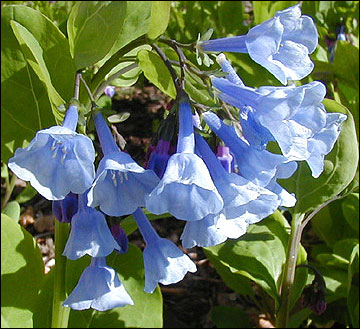 Virginia bluebell graces the spring woodlands with brilliant blue blossoms.
Virginia bluebell graces the spring woodlands with brilliant blue blossoms.
Characteristics in landscapes
If you are interested in developing a wildflower area in your landscape, several characteristics of these plants should be considered:
- No plant in the garden should be a noxious weed. Nor should any plant be so aggressive that it will invade other areas or crowd out nearby desirable wildflowers. Tables 1 and 2 list some plants that are particularly aggressive.
- The plant must be either a perennial or an annual that self-seeds to maintain itself from year to year, which helps eliminate the need to replace plants each year.
- The plant should have some showy characteristics to make it desirable in the wildflower area. The showy parts may be flowers, leaves, stems or seed structures.
- The plant must have a good root system so it can endure dry periods without watering and also help with conserving soil and preventing erosion.
- The plant should not be poisonous to humans or animals.
- The plant must be well-adapted to the conditions available. For example, it must be shade-tolerant for a woodland garden; sun- and drought-tolerant for a meadow garden; or water-tolerant for a bog garden.
- In some conditions, the plant must be able to compete and persist when mixed closely with other vegetation, such as grasses in the case of meadow plants, or trees in the case of woodland plants.
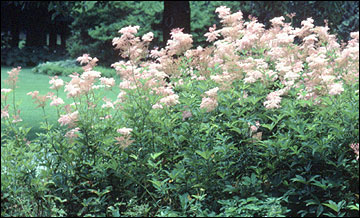
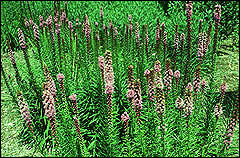
Too much fertilizer to tall wildflowers such as Filipendula and gayfeather can cause stems to fall over.
Designing the wildflower garden
Many wildflowers may be used in combination with other perennials or annual flowers in a perennial border. Many people, however, prefer to have an area designed specifically for wildflowers to develop a naturalistic look with relatively low maintenance.
If you have an opportunity to visit native sites or state forests, note the plants that grow in those places. Compare the sites of plants you prefer to the area or areas in your own landscape. For instance, if your site is wooded and contains a lot of shade, then a woodland wildflower garden may be your only choice (Table 1). If the site is sunny and dry, a meadow, prairie or field collection of plants may be most suitable (Table 2 lists some sunny-site species).
Wildflowers are not tolerant of foot or animal traffic. Develop paths so that you and your guests can walk among the flowers, not on them. Don’t plant wildflowers in areas where animals may frequently run over them, as most wildflowers cannot endure the crushed foliage and soil compaction that may occur.
The actual placement of plants in the design is flexible. Nature is random, and the wildflower garden should reflect this appearance. Clusters, clumps or individual placements are quite useful. Perhaps the only arrangement to be avoided is that of plants in rows or precise geometric forms.
Woodland and meadow wildflowers
Woodland wildflowers have these basic needs:
- Light shade
- Adequate moisture
- Soil high in organic matter
- Well-drained soil
- A leaf mulch or other organic mulch that persists throughout the year
Meadow or field wildflowers have a different set of needs:
- Full sun for at least six to eight hours daily
- Adequate early-season moisture
- Well-drained soils with average to moderate fertility
- Protection by nearby noninvasive plants rather than mulch, although light mulch can be used
Meadow wildflowers are fairly drought tolerant in the late season and are weakened by overfertilization.
Shade
Most woodland wildflowers do not grow in dense shade. They are at their most attractive in light shade, which in nature tends to be near the edge of the forest or under tall trees with high branching. The more limited the moisture supply, the more important shade is during the heat of the day for good growth and survival. Some woodland wildflowers that flower in early spring become dormant by midsummer and will not be seen again until next season. These often grow before a dense canopy of leaves develops and can be used in more heavily shaded locations.
Moisture
Many native wildflowers are able to sustain considerable drying. However, others such as trillium, jack-in-the-pulpit and mayapple will grow and develop best where adequate moisture is available, particularly while they are growing rapidly or flowering. These plants also will go dormant in midsummer when dry conditions develop. Tree roots can be competitive for moisture, so you may need to provide additional moisture, particularly during establishment or drought periods.
Most meadow wildflowers listed in Table 2 are for dry fields or meadows. However, a few of the flowers listed are suitable for low, wet areas. These are noted in Table 2 and are by no means the only ones that might be used.
Soil
Wildflowers are adapted to certain native soils and can normally endure in conditions similar to those in which they grow in the wild. In the case of woodland wildflowers, organic matter is quite important. They normally grow in locations where leaves and other plant debris accumulate and become a part of the soil environment and a mulch. Organic matter helps hold moisture and helps soil stay loose and well-aerated. Liberal amounts of organic matter should be added to prepare woodland wildflower gardens. Leaf compost is particularly suitable.
Most woodland wildflowers need well-drained soil, but some that grow along creeks in wooded areas tolerate or may need wetter conditions. Cardinal flower, jewelweed and forget-me-not are prime examples of this group, but check individual plant needs to fit them into the proper soil moisture requirement. Tables 1 and 2 briefly indicate whether a plant needs wet, moist or relatively dry conditions to thrive.
Acidity
Wildflowers that thrive in Missouri generally can be expected to need soil that is somewhat acidic. Most plants listed will grow best in a pH range from about 5.5 to 6.2. However, most wildflowers are adaptable and are tolerant of a wider pH range. Soils that are to be used for wildflowers probably will not need to be limed unless the native soil is unusually acidic. Conduct a soil test to determine existing soil conditions when starting wildflowers in a location where wildflowers may not have been grown previously.
Mulch
Woodland wildflowers should not be grown in bare soil, as is often done with popular garden flowers. They need a mulch or the protection of a nearby low-growing, noncompetitive plant. Mulches keep soil cooler, maintain more uniform moisture and aid in winter protection. Oak leaves are a durable and suitable mulch for many woodland wildflowers, though most will benefit from a mulch of any type of leaf cover.
Mulch is less necessary for meadow or field wildflowers. However, they benefit from the protection of nearby low-growing plants. In Table 2, mulches are mentioned primarily for winter protection of species more suitable to warmer portions of the state.
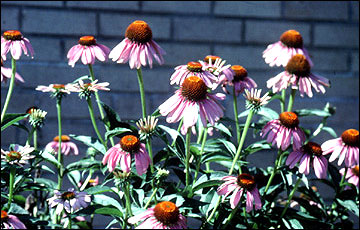 Purple coneflower, or Echinacea, is a durable, drought-resistant wildflower that enjoys great popularity for both its ornamental and its medicinal properties.
Purple coneflower, or Echinacea, is a durable, drought-resistant wildflower that enjoys great popularity for both its ornamental and its medicinal properties.
Field or meadow wildflower gardens
The field or meadow wildflower garden is different from woodland wildflower gardens. It is composed of a wide range of plants that flower in full sun or must have at least six hours of full sun each day to grow and flower well. Soils for these plants can generally be less fertile and lower in organic matter. Field wildflowers may grow better in better soils, but they are also more tolerant of poor growing conditions.
Another characteristic of these plants is that many can be easily seed propagated or planted directly. The most commonly available wildflower seed mixes are generally intended for this type of wildflower garden.
Although the meadow wildflower garden may be grown from divisions of larger plants, don’t overlook the seeding method, particularly if larger areas are to be covered economically. Seeds of meadow wildflowers may be planted at any time, but August and September are ideal. Many weed seeds will not germinate in fall, so wildflowers will germinate and get a head start on spring weeds. Plus, some wildflower seeds that require chilling conditions before germination will be chilled during the winter and germinate early in the spring.
Deep cultivation tends to bring up more weed seeds and is not essential for planting wildflowers unless the soil has been extremely compacted. After a sunny area has been selected, rake the area to loosen only the surface, no more than ½ inch deep. Spread the seeds or wildflower mix over the prepared area. After seeding, lightly rake over the area to establish good contact between the seeds and the soil. Water the area lightly to settle the soil and begin the germination process.
If the area selected already has perennial grasses and broad-leaved weeds on it, pull or kill the weeds before seeding. Weeds can be killed by spot treating with a glyphosate herbicide, such as Roundup. The grass also may be killed at that time or left in place on slopes or areas where wildflowers are wanted; erosion may occur if the grass is eliminated.
Some field wildflowers can exist in combination with grasses, but they should not be planted with grasses, such as fescue and rye grass, that grow aggressively during cool fall and spring weather. These vigorous cool-season grasses will crowd out the small wildflower seedlings during this period when they will grow little. If planting with grasses, mow the vegetation as short as possible. Remove the clippings and rough up the surface with a stiff rake, hoe, dethatcher or other equipment. Spread the seeds over the area, rake them in and water lightly.
These types of wildflower seeds should begin germination two to three weeks after planting. If natural rainfall is inadequate, maintain frequent light watering during the germination period to keep the soil surface moist but not overly wet.
Meadow wildflowers are of two types: perennials that return each year from the same plants and annuals that reseed readily each year. Those that reseed must be allowed to finish flowering and develop fully matured seeds before they are cut down in summer or fall.
In the spring after wildflower seedlings have become established, a pre-emergence herbicide might be used to reduce the development of annual grasses, such as crabgrass, in the area. This is crucial during the first season but less essential as the wildflowers become well established and soil is undisturbed.
Propagating wildflowers
Collecting native plant seeds
Once your own plants are established, you will be able to get additional seeds from them. In the meantime, seed collection can be an interesting hobby. Selective collection of seeds from an area with a sizable group of wildflowers will have little or no effect on their reproduction. Although wildflowers may be obvious in bloom, they often become hard to find by the time seeds are mature, so some advance scouting and marking may be necessary. Then you may need to keep a careful eye on developing seeds, to pick them after seed heads begin to brown but before seeds drop out. Seed stalks are best left on the plants for at least a month after flowering.
After collecting seed structures, open them to examine seeds contained. Seeds come in many different forms and sizes but will generally be fairly plump and firm if they are viable. Some plants may not produce seeds if conditions have not been favorable during the pollination or development stages.
Many wildflower seeds have a dormant period and will not germinate immediately. However, if planted promptly after harvest, this dormancy may not develop and rapid germination will occur. In the tables where midsummer or early-fall planting is suggested, this means prompt planting after harvest of the seeds.
If dormancy is natural or does develop, chilling is necessary before germination can be completed. Summer or fall planting is one way to fulfill these needs easily. Seeds that require chilling will not germinate in fall but will germinate early in spring.
Some seeds have a hard coat that must break down naturally in the soil before germination can occur. Hard seed coats are often found in plants of the legume family. With these types of seeds, a process called scarification can speed germination. Scarification techniques include filing a small area on individual seeds; cutting a nick into the coat with a knife; or treating with acid. Many techniques can be used, but nature will do the job if given time.
Asexual propagation
Any type of plant multiplication that does not involve seeds is known as asexual propagation. Several methods are applicable to wildflowers, depending on the plant involved.
Division
Division is probably the most suitable and easiest method for multiplying many wildflowers. Division should be done when plants are dormant and not actively growing, rather than when they are flowering. Many of the spring-blooming woodland wildflowers should be divided either in the fall as growth ceases or at when the natural growth is yellowing and collapsing.
At the proper time, carefully lift the entire plant, along with its roots, from the garden with a spade. Remove excess soil and trim back any dead top growth. Some plants that produce multiple offsets in the crown, such as black-eyed Susan (Figure 3), can be divided by pulling them apart. Woody plants may have to be cut apart with a knife or pruning shears. After division, the smaller plants should be replanted immediately at the same depth at which they had been previously growing.
Root cuttings
Root cuttings are suitable for propagating a few wildflowers with fleshy roots. Butterfly weed is one wildflower that can be multiplied by this technique.
In most plants, root cuttings should be made in early spring before top growth begins. Remove some of the largest roots from a clump. Ideally, in most plants the roots should be thick, at least the diameter of a pencil. Cut roots into pieces about 3 inches long. Plant them in a pot, flat or cold frame; a growth medium of half sand and half peat moss works well for many plants. Plant roots either horizontally or in the same position they were growing, but do not plant them upside down. The top should be at soil level with the root preferably in a vertical position.
In several weeks, shoots should develop from the roots. Do not be in a rush to move them into the garden. Wait until they are well-developed.
Stem cuttings
Stem cuttings are used less for wildflowers than for many other plants. However, this propagation technique is still useful in some cases. Young basal shoots generally make more suitable stem cuttings than older, more mature or flowering stems. The methods for rooting these cuttings are the same as those for softwood cuttings of many ornamental plants. Information in this area is limited, so trial and error may be necessary for determining possibilities with untested species.
Suggestions for home gardens
Tables 1 and 2 list wildflowers that may be grown in home wildflower gardens. Table 1 lists wildflowers suitable for woodland or lightly shaded locations. Table 2 lists meadow or field wildflowers best suited for full sun. Many other wildflowers could be included, but space does not permit. For the most part, those listed are easily grown and noninvasive. However, a few that are difficult to grow and some that tend to be aggressive are included for suiting all needs or locations.
Brief information on bloom time, color, height, soil conditions, propagation and special considerations is included. In each table, plants are listed alphabetically by common name, followed by their scientific name.
Common names vary, so you may know a certain plant listed by another name. Also, many plants closely related to the plants listed may be quite suitable. For instance, purple coneflower is listed, but several other plants known as coneflowers, including gray-head coneflower, pale coneflower, Mexican hat and thin-leaved coneflower (also called brown-eyed Susan), could be used in similar sites.
Wildflower seed mixes may contain seeds not found in these tables, which list mainly flowers that can be found growing natively in Missouri. However, other flowers in mixes may also be suitable for Missouri but not normally found unless introduced. Use the plants suggested in the tables as a guide to a beginning garden, but do not be limited by them.
Table 1
Woodland wildflowers suitable for a wildflower garden in a shaded or lightly shaded location.
| Woodland wildflowers | Bloom time | Major color | Height | Soil type | Comments |
|---|---|---|---|---|---|
| Bellwort (Uvularia grandiflora) |
April, May | Yellow | 12 to 14 inches | Moist, humus | Mulch. Attractive foliage. |
| Bloodroot (Sanguinaria canadensis) |
March, April | White | 6 to 10 inches | Humus, dry, well drained | Sow seeds after collection. Needs sun. |
| Celandine poppy (Stylophorum diphyllum) |
March to May | Yellow | 10 to 18 inches | Moist, humus | Needs constant moisture, mulch |
| Columbine (Aguilegia canadensis) |
April, May | Red with yellow | 24 inches | Moist, rich humus | Difficult to transplant. Self-sows easily. |
| Dog-tooth violet (Erythronium americanum) |
March, April | Yellow | 4 to 10 inches | Moist, humus | Needs spring sunlight. Takes 4 to 7 years to bloom from seeds. |
| Dutchman's breeches (Dicentra cucullaria) |
April | White | 4 to 12 | Moist, humus | Needs constant moisture. Mulch. |
| False Solomon's seal (Smilacina racemosa) |
April, May | White | 12 to 36 inches | Moist, rich humus | Arching growth. Red berries. Tall groundcover. |
| Fire pink (Silene virginica) |
April, May | Brilliant red | 24 inches | Dry, sandy, well drained | Fragrant. Needs some sun. Use mulch. |
| Goat's beard (Aruncus diocus) |
May, June | Creamy white | 48 to 60 inches | Moist, rich | Male and female plants. |
| Golden seal (Hydrastis canadensis) |
April, May | White | 12 to 15 inches | Moist, rich, well drained | Endangered plant. Red berries. |
| Great blue lobelia (Lobelia siphilitica) |
August, September | Blue | 12 to 36 inches | Wet, rich, humus | Also for wet meadows. Mulch for winter. |
| Green dragon (Arisaema dracontium) |
April, May | Greenish yellow | 12 to 48 inches | Wet, rich, humus | Full sun to light shade. Good near ponds. |
| Jack-in-the-pulpit (Arisaema triphyllum) |
April, May | Pale green, purplish | 6 to 24 inches | Wet, rich, humus | Needs wet shaded site. Mulch. |
| Jacob's ladder (Polemonium reptans) |
April, May | Blue-lavender | 15 inches | Moist, rich, humus | Moist woods or near ponds |
| Jewelweed (Impatiens capensis) |
May to October | Orange | 24 to 48 inches | Moist, rich, humus | Annual plant. Can become weedy. |
| Mayapple (Podophyllum peltatum ) |
April, May | White | 12 to 18 inches | Moist, rich, humus | Forms woodland groundcover. Needs constant moisture. |
| Rue anemone (Anemonella thalictroides) |
April, May | White | 4 to 6 inches | Humus, well-drained | Needs filtered light. Tolerates moist sites. |
| Solomon's seal (Polygonatum canaliculatum) |
May, June | White | 24 to 48 inches | Rich, moist, humus | Tolerates many conditions. P. biflorum useful. |
| Tall bellflower (Campanula americana) |
June to October | Blue | Up to 72 inches | Rich, moist, humus | Annual. Reseeds easily. May become weedy. |
| Toothwort (Dentaria laciniata) |
March, April | White to pale lavender | 4 to 12 inches | Rich, moist, humus | Moderate shade. Mulch. Deeply cut leaves. |
| Violet (Viola species) |
March to May | Blue, white, yellow | 4 to 10 inches | Rich, moist, humus | Grows almost anywhere. Self-seeds easily. |
| Virginia bluebells (Mertensia virginica) |
March, April | Light blue | 12 to 20 inches | Well drained, humus, dry | Sow seeds as soon as collected. In dry sites, mulch. |
| Wake robin, Trillium (Trillium species) |
April, May | Maroon, white, yellow | 8 to 16 inches | Rich, humus, moist | Filtered light in spring, shade thereafter. Mulch. Give good drainage. |
| Wild geranium (Geranium species) |
April, May | Lavender | 10 to 18 inches | Rich, moist | Takes partial sun. Mulch. Cut rhizomes for division. |
| Wild ginger (Asarum canadense) |
April, May | Reddish brown | 4 to 6 inches | Rich, moist | Roots have aroma of ginger. |
| Wild sweet William (Phlox divaricata) |
April, May | Blue, light violet | 10 to 20 inches | Moist, humus | Perennial. Easily grown. |
Table 2
Meadow and field wildflowers suitable for sunny, open locations.
| Meadow wildflowers | Bloom time | Major color | Height | Soil type | Comments |
|---|---|---|---|---|---|
| Beard tongue (Penstemon species) |
May to July | White, pink, purple | 18 to 48 inches | Average, well drained | Self-sows easily. Takes light shade or full sun. |
| Bee balm, Bergamot (Monarda species) |
June to August | Lavender, pink, red | 24 to 48 inches | Average, well drained | Tolerates light shade, many soil types |
| Black-eyed Susan (Rudbeckia hirta) |
June to October | Golden yellow | 12 to 24 inches | Average, well drained | Self-sows easily. Avoid excess fertilization. |
| Blue false indigo (Baptisia australis) |
May | Blue | 24 to 48 inches | Average, well drained | Also white and yellow species. Black seed pods. |
| Blue flag (Iris virginica) |
May to July | White to deep violet | 24 to 36 inches | Average, wet | Very attractive. Needs moist soil. |
| Blue sage (Salvia azurea) |
August, September | Azure blue | 36 to 48 inches | Average, well-drained | Attractive, long slender flower species. |
| Blue star (Amsonia illustris) |
April, May | Light blue | 18 to 36 inches | Moist but well-drained | Shiny leaves very attractive. |
| Butterfly weed (Asclepias tuberosa) |
May to September | Orange | 12 to 36 inches | Average dry, well-drained | Perfect drainage important. Tolerates light shade. |
| Cardinal flower (Lobelia cardinalis) |
July to September | Bright red | 24 to 36 inches | Average, wet | Must be kept moist at all times. Mulch. |
| Compass plant (Silphium laciniatum) |
July to October | Yellow | 48 to 60+ inches | Average | Vigorous. Gets large. |
| Coreopsis (Coreopsis lanceolata) |
May to August | Yellow | 12 to 36 inches | Average, well-drained | Self-sows readily. Drought tolerant, soil tolerant. |
| Gayfeather, Blazing star (Liatris species) |
July to October | Lavender-pink | 24 to 48 inches | Fertile, well-drained | Good flower for cutting. Mulch for winter. |
| Goldenrod (Solidago species) |
July to October | Yellow, white | 12 to 60 inches | Poor to average, well-drained | Self-sows easily. Tolerates light shade. |
| Gray-head coneflower (Ratibida pinnata) |
May to September | Yellow | 36 to 48 inches | Poor to average | Gray disks with drooping yellow ray floret petals. |
| Indian paint brush (Castilleja coccinea) |
April to July | Red, orange | 8 to 24 inches | Average, moist | Annual. Difficult. |
| Missouri coneflower, Missouri black-eyed Susan (Rudbeckia missouriensis) |
June to October | Yellow | 18 inches | Average, well-drained | Common wildflower in Ozark region of Missouri. |
| Missouri primrose (Oenothera macrocarpa) |
May to July | Yellow | 8 to 10 inches | Average dry, well-drained | Large flowers, evening bloom. Good rock garden plant. |
| New England aster (Aster novae-angliae) |
July to September | Violet | 36 to 60 inches | Average, moist | Top shoots in late spring to create lower, bushier plant |
| Ox-eye (Heliopsis helanthoides) |
July to September | Yellow | 24 to 60 inches | Average | May require support. |
| Pale-purple coneflower (Echinacea pallida) |
May to June | Rose to magenta | 24 to 36 inches | Average | Tolerates poor soil. |
| Purple coneflower (Echinacea purpurea) |
July to October | Reddish purple | 24 to 36 inches | Average, well drained | Durable, long lasting. Drainage important. |
| Purple poppy mallow (Callirhoe involucrata) |
June to July | Purple | 24+ inches | Average | Likes dry, sunny locations. |
| Purple prairie clover (Petalostemon purpurea) |
June to September | Rose-purple | 24 to 36 inches | Poor to average | Common clover. Easily grown. |
| Queen-of-the-prairie (Filipendula rubra) |
June to August | Pink-red | 24 to 72 inches | Average, moist | Impressive but large. |
| Rattlesnake master, Button snakeroot (Eryngium yuccifolium) |
July through August | Greenish white | 18 to 48 inches | Average, well drained | Attractive seed heads provide late summer and fall interest. |
| Rock pink (Talinum calycinum) |
May to August | Red | 6 to 12 inches | Average, shallow | Succulent-like, Tolerates poor, rocky soil. |
| Rose verbena (Verbena canadensis) |
March to November | Rose, magenta | 6 to 12 inches | Poor to average, well-drained | Self-sows. Needs full sun. Cannot compete with tall plants. Mulch. |
| Shooting star (Dodecatheon meadia) |
April, May | Pink | 12 to 18 inches | Rich, dry and well-drained | Drought tolerant. Cannot compete with large plants. Mulch. |
| Showy evening primrose (Oenothera speciosa) |
May, June | Pink, white | 6 to 12 inches | Poor to average, well-drained | Spreads easily. Mulch for winter protection. |
| Skullcap (Scutellaria incana) |
June to August | Purple | 24 to 30 inches | Average, well-drained | Seeds shaped like a cap, hence its name. |
| Sneezeweed (Helenium autumnale) |
August to November | Yellow | 48 to 72 inches | Average, moist | Rank grower. Suitable for background use. |
| Spiderwort (Tradescantia ohiensis) |
April to July | Blue | 12 to 24 inches | Poor to average, well-drained | Tolerates light shade. Cut flower stems for repeat bloom. |
| Sunflower (Helianthus species) |
July to October | Yellow | 48+ inches | Average, poor | Seeds attract birds. |
| Sweet coneflower (Rudbeckia subtomentosa) |
July to October | Yellow | 48 to 72 inches | Average, moist | Similar to black-eyed Susan. |
| White upland aster (Aster ptarmicoides) |
July to September | White | 24 to 30 inches | Average, well-drained | Drainage important. Can grow in almost pure sand. |
| Wild pink (Silene caroliniana) |
April to May | Rosy pink | 6 to 8 inches | Acid, well-drained | Excellent drainage important. Suitable for rock gardens. |
| Yarrow (Achillea species) |
June to September | White, pink, yellow | 12 to 36 inches | Average, well-drained | Mulch. Tolerates light shade. |
| Yellow coneflower (Echinacea paradoxa) |
June, July | Yellow | 24 to 36 inches | Average, well-drained | An uncommon native plant suitable for gardens. |
Original author
Ray R. Rothenberger, Department of Horticulture
